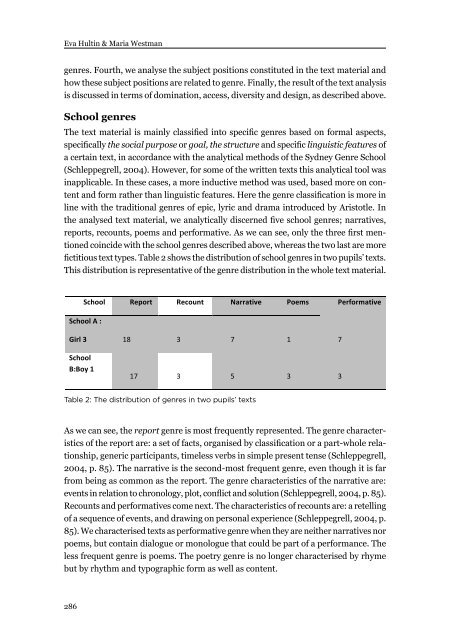Download issue - Umeå universitet
Download issue - Umeå universitet
Download issue - Umeå universitet
Create successful ePaper yourself
Turn your PDF publications into a flip-book with our unique Google optimized e-Paper software.
Eva Hultin & Maria Westman<br />
genres. Fourth, we analyse the subject positions constituted in the text material and<br />
how these subject positions are related to genre. Finally, the result of the text analysis<br />
is discussed in terms of domination, access, diversity and design, as described above.<br />
School genres<br />
The text material is mainly classified into specific genres based on formal aspects,<br />
specifically the social purpose or goal, the structure and specific linguistic features of<br />
a certain text, in accordance with the analytical methods of the Sydney Genre School<br />
(Schleppegrell, 2004). However, for some of the written texts this analytical tool was<br />
inapplicable. In these cases, a more inductive method was used, based more on content<br />
and form rather than linguistic features. Here the genre classification is more in<br />
line with the traditional genres of epic, lyric and drama introduced by Aristotle. In<br />
the analysed text material, we analytically discerned five school genres; narratives,<br />
reports, recounts, poems and performative. As we can see, only the three first mentioned<br />
coincide with the school genres described above, whereas the two last are more<br />
fictitious text types. Table 2 shows the distribution of school genres in two pupils’ texts.<br />
This distribution is representative of the genre distribution in the whole text material.<br />
more in line with the traditional genres of epic, lyric and drama introduced by Aristotle. In the <br />
analysed text material, we analytically discerned five school genres; narratives, reports, recounts, <br />
poems and performative. As we can see, only the three first mentioned coincide with the school <br />
genres described above, whereas the two last are more fictitious text types. Table 2 shows the <br />
distribution of school genres in two pupils’ texts. This distribution is representative of the genre <br />
distribution in the whole text material. <br />
School Report Recount Narrative Poems Performative <br />
School A : <br />
Girl 3 18 3 7 1 7 <br />
School <br />
B:Boy 1 <br />
17 3 5 3 3 <br />
Table 2: The distribution of genres in two pupils’ texts <br />
Table 2: The distribution of genres in two pupils’ texts<br />
As we can see, the report genre is most frequently represented. The genre characteristics of the <br />
report are: a set of facts, organised by classification or a part-‐whole relationship, generic participants, <br />
As we can see, the report genre is most frequently represented. The genre characteristics<br />
frequent of the genre, report even are: though a set it is of far facts, from organised being as common by classification as the report. or The a genre part-whole characteristics rela-<br />
<br />
timeless verbs in simple present tense (Schleppegrell, 2004, p. 85). The narrative is the second-‐most <br />
tionship, of the narrative generic are: participants, events in relation timeless to chronology, verbs in plot, simple conflict present and solution tense (Schleppegrell, 2004, <br />
2004, p. 85). p. Recounts 85). The and narrative performatives is the come second-most next. The characteristics frequent genre, of recounts even are: though a retelling it is of far a <br />
from sequence being of as events, common and drawing as the on report. personal The experience genre characteristics (Schleppegrell, 2004, of the p. 85). narrative We are:<br />
events characterised in relation texts to as chronology, performative plot, genre conflict when they and are solution neither narratives (Schleppegrell, nor poems, 2004, but p. contain 85). <br />
Recounts<br />
dialogue or<br />
and<br />
monologue<br />
performatives<br />
that could<br />
come<br />
be part<br />
next.<br />
of a<br />
The<br />
performance.<br />
characteristics<br />
The less<br />
of<br />
frequent<br />
recounts<br />
genre<br />
are:<br />
is <br />
a<br />
poems.<br />
retelling<br />
The <br />
poetry genre is no longer characterised by rhyme but by rhythm and typographic form as well as <br />
of a sequence of events, and drawing on personal experience (Schleppegrell, 2004, p.<br />
content. <br />
85). We characterised texts as performative genre when they are neither narratives nor<br />
Almost all school genres are prescribed by the teacher, not the least through giving certain <br />
poems, sentence but patterns contain the dialogue pupils are or encouraged monologue to use, that for could instance be in part the reports of a performance. I can, I want to, The My <br />
less family frequent (more detailed genre is examples poems. follow The in poetry the sections genre below is no on longer sub-‐genres). characterised In some cases, by rhyme however, <br />
but a text by written rhythm in and a certain typographic school genre form is the as result well of as the content. pupil’s interpretation of the task. When all <br />
children write a text that we categorise as a recount, entitled In winter, one boy instead writes a <br />
story set in winter, but told as a narrative with a clear conflict that obtains a solution. In this case, <br />
286<br />
one could say that this boy gained agency with which he could express himself in a form that suited <br />
him since he resisted living up to the genre expectations as the other children did. Another example <br />
of this is when all children were to write a fairy tale with its classic genre characteristics such as once <br />
upon a time and they lived happily ever after. However, one boy did not write a fairy tale but a report

















